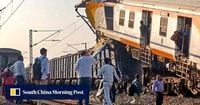On November 4, 2025, the heart of India’s Chhattisgarh state was shaken by a tragic train collision near Bilaspur, a city located roughly 116 kilometers (72 miles) from the state capital, Raipur. The accident, which involved a local passenger train and a stationary goods (freight) train, left at least eight people dead and more than a dozen others injured, according to multiple official sources, including reporting from ANI and the Associated Press.
Eyewitnesses and officials described a chaotic and harrowing scene in the aftermath of the crash. The passenger train, known as a MEMU local, slammed into the rear of the parked freight train, causing the front coaches of the passenger train to crumple and topple over. In a particularly grim detail, one of the passenger cars ended up perched atop a wagon of the goods train. The collision’s force left some passengers trapped inside the twisted metal, prompting a desperate rescue effort that stretched into the evening.
“A total of eight people have lost their lives in this accident. Two people are still stuck here. 16-to-17 people are in a serious condition. This is a big accident,” district official Sanjay Agarwal told the ANI news agency. Agarwal further explained that a rescue team was “trying to cut through the train to take out at least two passengers trapped inside,” adding, “We hope they will be alive but can’t confirm until we get them out.” These words, echoed by other officials on the ground, captured the urgency and gravity of the situation as rescue workers raced against time.
Indian Railways, the country’s vast and complex rail network operator, responded by deploying all available resources to the site. According to a statement from Indian Railways cited by multiple outlets, injured passengers were swiftly transported to nearby hospitals for immediate medical attention. Senior officials arrived at the crash site to oversee relief and rescue operations, which were initiated on what the administration called a “war footing.” The railway administration also coordinated closely with district authorities and medical teams to ensure that relief measures proceeded as quickly as possible.
For families and relatives desperate for news, the railway administration made several emergency helpline numbers operational. These included contacts for Bilaspur (7777857335, 7869953330), Champa (8085956528), Raigarh (9752485600), Pendra Road (8294730162), Korba (7869953330), and Uslapur (7777857338). Passengers and their loved ones were encouraged to reach out to these numbers for information and assistance, as officials worked to keep everyone informed amid the confusion.
In a move to provide some measure of relief to those affected, the railway administration announced ex-gratia compensation for victims and their families. The compensation package included Rs 10 lakh (approximately $11,300) to the next of kin of the deceased, Rs 5 lakh to those grievously injured, and Rs 1 lakh to those with minor injuries. The announcement, confirmed by both Indian Railways and the ANI news agency, was intended to support those facing unimaginable loss and hardship in the wake of the disaster.
The aftermath of the crash also triggered an official investigation. Indian Railways confirmed that a detailed inquiry would be conducted at the level of the commissioner of railway safety (CRS), with the aim of determining the precise cause of the collision and recommending necessary corrective actions. While the immediate focus remained on rescue and relief, the promise of a thorough investigation underscored the seriousness with which authorities were treating the incident.
Initial reports from officials, including Chhattisgarh’s Deputy Chief Minister Arun Sao, indicated that the freight train was stationary at the time of the accident. The local passenger train, for reasons yet to be fully determined, crashed into the rear of the goods train. The collision’s impact was so severe that it caused the first few coaches of the passenger train to sustain significant damage, and, as previously mentioned, led to one coach ending up on top of a goods wagon.
Scenes from the site, broadcast on Indian television and shared by international outlets like the Associated Press and South China Morning Post, showed rescue workers sifting through the debris, using cutting tools to reach those trapped inside. The images were a stark reminder of the vulnerability faced by millions who depend on India’s railways for daily travel.
India’s rail network, the fourth largest in the world, is both a marvel and a challenge. Stretching across 64,000 kilometers of track and carrying more than 12 million passengers each day, the system is a lifeline for the country’s vast population. Yet, as noted by the Associated Press and other outlets, the network is plagued by issues of aging infrastructure and human error. Despite ongoing government efforts to improve rail safety, several hundred accidents occur annually, with many attributed to outdated signaling systems or lapses in operational discipline.
The Bilaspur tragedy is the latest in a series of deadly rail accidents that have raised urgent questions about safety and accountability. In 2023, for example, one of India’s worst rail disasters occurred in Odisha, where a three-train collision claimed the lives of 288 people. Such incidents have prompted repeated calls for systemic reforms, increased investment in modernization, and a stronger focus on training and oversight.
For the families of those killed and injured in Bilaspur, however, these broader debates are of little comfort in the immediate aftermath. The swift deployment of rescue teams, the provision of compensation, and the promise of an independent inquiry offer some assurance that authorities are taking the tragedy seriously. But for many, the overriding question remains: how can such accidents be prevented in the future?
As India continues to grapple with the challenges of maintaining and upgrading its vast rail infrastructure, the Bilaspur accident stands as a somber reminder of the human cost of lapses in safety. The coming weeks will likely bring further details from the official inquiry, as investigators sift through evidence to determine what went wrong and how similar disasters might be averted. Until then, the focus remains on supporting the affected families and ensuring that those injured receive the care they need.
In the days ahead, the memory of those lost near Bilaspur will weigh heavily on the nation’s conscience—and on the resolve of those tasked with keeping India’s trains safe for all.






